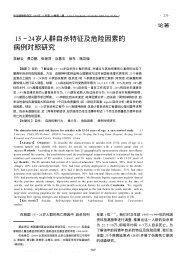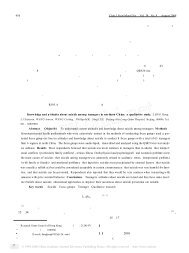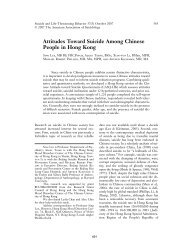Interventions for Suicide Survivors: A Review of the Literature
Interventions for Suicide Survivors: A Review of the Literature
Interventions for Suicide Survivors: A Review of the Literature
Create successful ePaper yourself
Turn your PDF publications into a flip-book with our unique Google optimized e-Paper software.
338 <strong>Interventions</strong> <strong>for</strong> <strong>Suicide</strong> <strong>Survivors</strong><br />
vivors. Second, given <strong>the</strong> lack <strong>of</strong> research de- ceive. In a telephone survey <strong>of</strong> 144 next-<strong>of</strong>-<br />
voted to interventions with suicide survivors, kin survivors, Provini et al. (2002) found that<br />
we provide a short discussion <strong>of</strong> recent re- approximately one quarter <strong>of</strong> <strong>the</strong>ir sample in-<br />
views <strong>of</strong> <strong>the</strong> research into <strong>the</strong> efficacy <strong>of</strong> dicated specific concerns (18%) and needs<br />
psychosocial interventions after all types <strong>of</strong> (26%), while approximately one third indi-<br />
bereavement. Third, empirical studies <strong>of</strong> incated that <strong>the</strong>y had no specific concerns<br />
terventions specifically <strong>for</strong> suicide survivors (35%) or needs (31%). Only about 25% indi-<br />
will be reviewed. Finally, conclusions are cated that <strong>the</strong>y had received ei<strong>the</strong>r <strong>for</strong>mal or<br />
drawn and recommendations made <strong>for</strong> im- in<strong>for</strong>mal help since <strong>the</strong> suicide, although <strong>for</strong>-<br />
proving future research ef<strong>for</strong>ts. While <strong>the</strong>re mal help was listed as a <strong>for</strong>m <strong>of</strong> assistance<br />
is a small amount <strong>of</strong> literature on interven- desired by almost three quarters <strong>of</strong> those who<br />
tions with child and adolescent suicide survi- indicated a need <strong>for</strong> help. Family related<br />
vors (see <strong>for</strong> example, Pfeffer, Jiang, Kakuma, problems were <strong>the</strong> most frequently men-<br />
Hwang, & Metsch, 2002), a full review <strong>of</strong> intioned types <strong>of</strong> concerns, with families conterventions<br />
<strong>for</strong> child survivors is beyond <strong>the</strong> taining minor children expressing signifi-<br />
scope <strong>of</strong> this article.<br />
cantly more concerns than those without<br />
children. Bereaved widows and parents appeared<br />
to be underrepresented in <strong>the</strong> study,<br />
REPORTED NEEDS<br />
and <strong>the</strong> sample was also relatively young,<br />
OF SURVIVORS with 42% <strong>of</strong> respondents in <strong>the</strong> 25–44 age<br />
range. Approximately one third <strong>of</strong> <strong>the</strong> sample<br />
Estimates <strong>of</strong> <strong>the</strong> number <strong>of</strong> impacted felt able to cope without any assistance.<br />
survivors after a completed suicide vary wide- In ano<strong>the</strong>r recent study <strong>of</strong> 179 Norwe-<br />
ly, from six to several hundred, depending on gian survivors, Dyregrov (2002) found that<br />
<strong>the</strong> operational definition <strong>of</strong> survivorhood bereaved survivor parents experienced high<br />
(Crosby & Sacks, 2002; Provini, Everett, & levels <strong>of</strong> psychosocial distress on measures <strong>of</strong><br />
Pfeffer, 2000; Wrobleski, 1991). A recent and general health functioning, traumatization,<br />
methodologically sound national telephone and complicated bereavement, along with<br />
survey <strong>of</strong> 5,238 respondents indicated that as considerably greater levels <strong>of</strong> perceived and<br />
much as 7% <strong>of</strong> <strong>the</strong> U.S. population (approxi- unmet needs <strong>for</strong> services and support than<br />
mately 13.2 million people) has been exposed <strong>the</strong> Provini et al. sample. For example, 88%<br />
to a suicide within <strong>the</strong> last 12 months, with <strong>of</strong> <strong>the</strong> participants expressed <strong>the</strong> need <strong>for</strong><br />
approximately 1.1% <strong>of</strong> <strong>the</strong> sample having lost pr<strong>of</strong>essional help <strong>for</strong> <strong>the</strong>ir bereavement. Eighty-<br />
an immediate family member (Crosby & five percent reported that <strong>the</strong>y had already<br />
Sacks, 2002). It is important to note, how- received some kind <strong>of</strong> contact with commuever,<br />
that <strong>the</strong> question <strong>of</strong> what constitutes nity pr<strong>of</strong>essionals, and about half had experi-<br />
“survivorhood” is one that has not been set- enced direct outreach from pr<strong>of</strong>essionals.<br />
tled <strong>for</strong> ei<strong>the</strong>r clinical or research purposes, This support, however, was typically <strong>of</strong> short<br />
since it has not been established that expo- duration (67% less than 6 months), and was<br />
sure to suicide necessarily results in <strong>the</strong> nega- <strong>of</strong>fered shortly after <strong>the</strong> loss. Thus, many retive<br />
effects implied in <strong>the</strong> term survivor. At spondents expressed <strong>the</strong> need <strong>for</strong> on-going<br />
this point in <strong>the</strong> development <strong>of</strong> our knowl- and longer term outreach from caregivers,<br />
edge, we simply do not have good data about since <strong>the</strong>y had difficulty initiating <strong>the</strong> search<br />
<strong>the</strong> percentages <strong>of</strong> exposed people who are <strong>for</strong> help on <strong>the</strong>ir own, given <strong>the</strong>ir emotion-<br />
significantly impacted in a negative way by ally traumatized state. Similar to <strong>the</strong> Provini<br />
suicide (American Foundation <strong>for</strong> <strong>Suicide</strong> et al. sample, respondents expressed a strong<br />
Prevention, 2003; McIntosh, 1999). need <strong>for</strong> help with supporting minor children<br />
Likewise, very few empirical studies after <strong>the</strong> suicide, as well as targeted help in<br />
have addressed <strong>the</strong> question <strong>of</strong> what types <strong>of</strong> dealing with posttraumatic experiences <strong>of</strong> in-<br />
support services survivors need or actually re-trusive<br />
memories and images. Dyregrov also

















